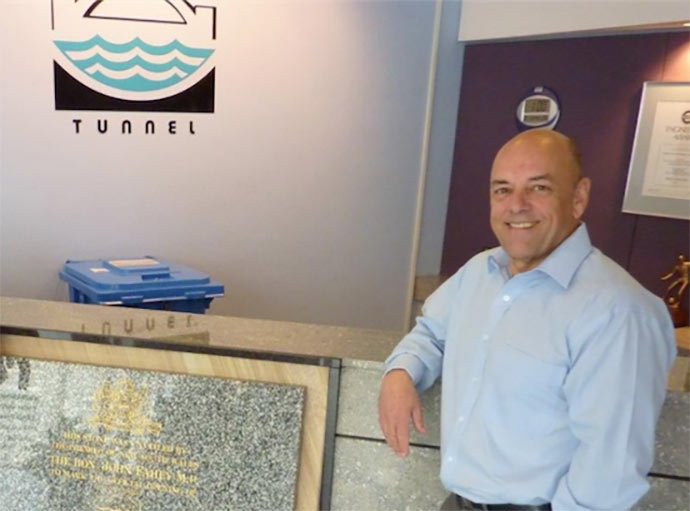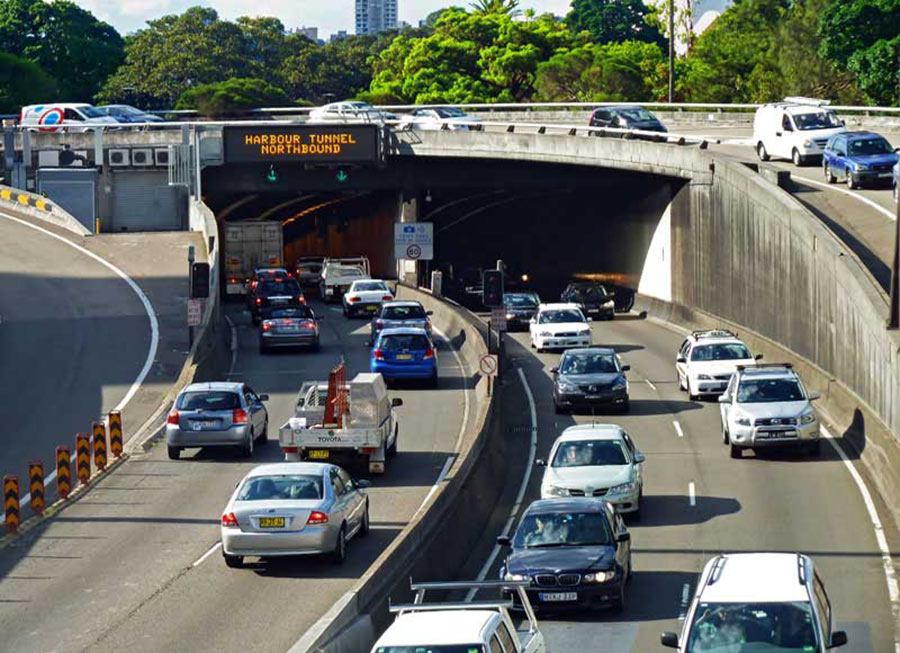Managing safety under Sydney Harbour 24 Aug 2017
The Sydney Harbour highway tunnel, living in the shadow of the other main way of vehicular traffic crossing, the Sydney Harbour Bridge, celebrates 25 years of successful operation this month, August 2017. As Australia’s first and only subsea road tunnel, General Manager of the Sydney Harbour Tunnel, Bob Allen speaks of the tunnel and its operation.
“It is a comment that was made many years ago, not by me, but I will repeat it – it is an invisible landmark,” said Allen of the immersed tube crossing that provides the four lanes of northbound traffic in combination with the southbound lanes carried on the bridge above.
The quiet achiever took five years to construct, and Allen, who was the opening controller at 3 o’clock in the morning on 31 August 1992, explains that a crew of about 32 currently ensures the tunnel remains available to traffic at all times.
The 2.3km tunnel links the Warringah Freeway and Cahill Expressway and is used by an average of 102,000 vehicles every day.
A number of features have been added over time to ensure the smooth progress of these vehicles, and that the asset is kept modern and relevant.
“The water screen, as we call it, or the Softstop Barrier, was developed after a fire in the tunnel in 2003 where motorists just would not stop,” explains Allen. “Motorists were driving into the tunnel, with a car on fire just over 2km into the tunnel. Some even did U-turns and then travelled south on the northbound carriageway, ignoring all the lights and stop signs in the tunnel.”
Developed with Laservision, the curtain of water has light projected onto it, giving the illusion of a solid surface sign in the portal of the tunnel.
Fires like the one that prompted development of the sign are thankfully rare and the sign is used more frequently today as a last line of defence against over-height trucks that have ignored warning lights and signs on entering the tunnel. Traffic lights were later installed on the southbound approach to the tunnel.
“Until the lights were installed, the water screen was used two to three times a week to stop trucks who just were not paying attention to the height restrictions,” added Allen.
Over-height vehicles ignoring signs can be a major problem. Infrared light beams on a pedestrian footbridge about 1km before the tunnel entrance trigger a warning for any over-height trucks to use the northbound lane on the bridge, instead of the tunnel, “and by far, the majority of truck drivers do,” said Allen. “You can imagine how many trucks are on the road, and if they all ignored the signs we would be stopping traffic every five minutes, so the majority are doing the right thing. It is just that when the minority ignore the signs or make a mistake, it has a high impact.”
The confined space within tunnels mean that identifying and dealing with fires accurately and quickly is essential. The tunnel has a manually-operated deluge sprinkler system. There is also vortex fire suppression systems in the control and computer rooms.
Maintenance and operational regimes are also in place to ensure the tunnel is upgraded to keep it fitted with state of the art systems. To achieve this the tunnel is closed regularly to allow access for maintenance personnel and contractors to work in a safe environment.
Allen explains, for example, that computers have been upgraded three times and a fibre optic network installed “so we can go to an IP protocol. But we are not connected to the outside world so we are protected from attack by viruses or persons with malicious intent. Installing the fibre network and connecting to all devices remains a work in progress, with only about five hours a night available to work on the task, which has been running for about five years.
“As part of our obligation to design, build, operate and maintain the tunnel for a 100-year design life, a major project has been undertaken in the last two years which we call the Enhanced Asset Management Plan. The tunnel design and construction has been reviewed, with the tunnel subjected to in-depth inspection including non-destructive testing and breakouts and removal of concrete cores. This has allowed best practice plans to be put in place for the inspection and ongoing maintenance of the actual concrete structure.”
“In addition, we do an annual 3D survey of the underwater tunnel. While there was some initial movement, this has now stabilised and is less than a one-third of allowable joint design movement,” said Allen.
The Tunnel Company, a joint venture between Transfield, Kumagai Gumi and Olbia, will operate the asset until 2022, at which point it will transfer to public ownership.
Asked what the biggest challenge was, Allen says it is simply ensuring the tunnel is kept fit for purpose “and that everybody comes in one end and goes out the other and I'm not trying to sound flippant, but that is really what we are here for.”
Footnotes
To expand the knowledge and understanding of the design, construction and operation of underground space, the 16th Australasian Tunnelling Society conference will convene in Sydney from 30 October – 1 November 2017. TunnelTalk is an official media partner with the conference and copies of the collectible TunnelTalk Annual Review industry year books from the first for 2010 will be available for free distribution at the event. Find out more about the conference and its programme at ats2017.com.au
References
- Sydney Metro awards mega extension project – TunnelTalk, June 2017
- TBM record for Sydney metro rail mega-project – TunnelTalk, February 2016
- Shortlist for last WestConnex contract – TunnelTalk, June 2017
- Tunnels at the heart of Sydney transport vision – TunnelTalk, October 2012
- Melbourne awards its PPP metro contract – TunnelTalk, July 2017
- Melbourne contracting model to minimize risk – TunnelTalk, November 2013
- First VDM prepares for launch in Perth – TunnelTalk, July 2017
- Brisbane revives Cross River rail project – TunnelTalk, April 2016
- Celebrating success at Legacy Way in Brisbane – TunnelTalk, December 2013
- Buried end for Brisbane Airport Link TBMs – TunnelTalk, January 2011
- Training roadheader operators in Sydney – TunnelTalk, August 2016
- TBM first for Australian coal seam access – TunnelTalk, November 2013
- Australia suffers toll concession failures – TunnelTalk, July 2013
- Final account on Sydney's alliance – TunnelTalk, November 2002
- Sydney Opera House car park – an iconic underground structure – TunnelTalk, September 2010
|
|
|
|
|
Add your comment
- Thank you for taking the time to share your thoughts and comments. You share in the wider tunnelling community, so please keep your comments smart and civil. Don't attack other readers personally, and keep your language professional.






